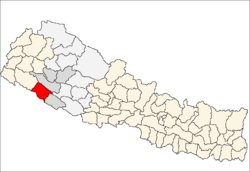Bardiya District
| Bardiya बर्दिया | |
|---|---|
| District | |
 Location of Bardiya | |
| Country | Nepal |
| Region | Mid-Western (Madhya-Pashchim Anchal) |
| Zone | Bheri |
| Headquarters | Gulariya |
| Area | |
| • Total | 2,025 km2 (782 sq mi) |
| Population (2011) | |
| • Total | 426,576[1] |
| Time zone | NPT (UTC+5:45) |
| Main language(s) | Tharu, Nepali, Awadhi |
Bardiya District (Nepali: बर्दिया जिल्ला![]() Listen ), one of the seventy-five Districts of Nepal, is part of Province No. 5 and is headquartered at the city of Gulariya. The district covers an area of 2,025 km² and according to the 2001 census the population was 382,649[2] in 2011 it has 426,576.[1]
Listen ), one of the seventy-five Districts of Nepal, is part of Province No. 5 and is headquartered at the city of Gulariya. The district covers an area of 2,025 km² and according to the 2001 census the population was 382,649[2] in 2011 it has 426,576.[1]
Geography and Climate
Bardiya lies in Province No. 5 in midwestern Nepal. It covers 2025 square kilometers and lies west of Banke District, south of Surkhet District of Province No. 6, east of Kailali District of Province No. 7. To the south lies Uttar Pradesh, India; specifically the Lakhimpur and Bahraich districts of Awadh.
Most of Bardiya is in the fertile Terai plains, covered with agricultural land and forest. The northernmost part of the district extends into the Churiya or Siwalik Hills. Bardiya National Park covers 968 km2 occupies most of the northern half of the district. This park is the largest undisturbed wilderness in Nepal's Terai. It provides forest, grassland and riverine habitat for engendered mammal, bird and reptile species. More than 30 species of mammals and more than 250 of birds have been recorded.
Most people living in this district are farmers. The district headquarters Gulariya lies on the Babai River. The Karnali, one of Nepal's largest rivers, divided into multiple branches when it reaches the Terai. The westernmost branch forms the boundary between Bardiya and Kailali districts. An eastern branch is called the Geruwa. The endangered Gangetic dolphin was often seen in its waters, but populations have been declining.[3]
| Climate Zone[4] | Elevation Range | % of Area |
|---|---|---|
| Lower Tropical | below 300 meters (1,000 ft) | 71.4% |
| Upper Tropical | 300 to 1,000 meters 1,000 to 3,300 ft. |
22.6% |
| Subtropical | 1,000 to 2,000 meters 3,300 to 6,600 ft. |
2.7% |
History
Bardiya was part of Kingdom of Nepal before it was ceded to the British East India Company in Sugauli Treaty during Partition of Nepal. Later during the administration of Jang Bahadur Rana, it was returned to Nepal along with Banke, Kailali and Kanchanpur. In the early twentieth century, Bardiya was still covered with forest and sparsely populated with indigenous tribal people called Tharu. Additional Tharus immigrated west from Dang and Deukhuri Valleys. Tharu from Dang and Deukhuri make up a majority of Bardiya's population. Other tribes called Sonaha live near the Karnali River and western periphery of Bardia National Park, who are historically engaged in extracting golden ores from sediments of river and fishing.
Village Development Committees and Municipalities in Bardiya

References
- 1 2 "National Population and Housing Census 2011(National Report)" (PDF). Central Bureau of Statistics. Government of Nepal. November 2012. Archived from the original (PDF) on April 18, 2013. Retrieved November 2012. Check date values in:
|access-date=(help) - ↑ "Nepal Census 2001". Nepal's Village Development Committees. Digital Himalaya. Archived from the original on October 12, 2008. Retrieved 12 December 2008.
- ↑ "River dolphins under threat in Nepal". WWF. 26 May 2006. Retrieved 26 May 2006.
- ↑ The Map of Potential Vegetation of Nepal - a forestry/agroecological/biodiversity classification system (PDF), . Forest & Landscape Development and Environment Series 2-2005 and CFC-TIS Document Series No.110., 2005, ISBN 87-7903-210-9, retrieved Nov 22, 2013
See also
- Zones of Nepal
- "Districts of Nepal". Statoids.
| Wikimedia Commons has media related to Bardiya District. |
Coordinates: 28°49′0″N 80°29′0″E / 28.81667°N 80.48333°E
